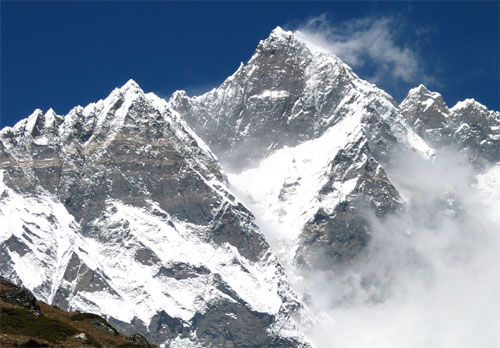India's diverse terrain offers a plethora of mountain peaks, each with its own distinct character. Here, we present the Top 10 highest Mountain Peaks in India that you absolutely cannot miss:
Kanchenjunga
Kanchenjunga, standing at an astonishing 8,586 meters (28,169 feet), is the crown jewel of the Eastern Himalayas. It's not just a peak; it's an epitome of natural beauty. The name itself translates to "The Five Treasures of Snow," reflecting the five peaks it comprises.
Mount K2
Also known as Mount Godwin-Austen, this mighty peak reaches a staggering 8,611 meters (28,251 feet). It is part of the Karakoram Range and is a challenging climb even for experienced mountaineers.
Kangchenjunga
Nestled in the Himalayas, Kangchenjunga stands tall at 8,586 meters (28,169 feet). It's a challenging climb, but the reward is a breathtaking view of pristine wilderness.
Nanda Devi
At 7,816 meters (25,643 feet), Nanda Devi is a favorite among trekkers. The Nanda Devi National Park surrounding it is a UNESCO World Heritage Site.
Kamet
Kamet, with an elevation of 7,756 meters (25,446 feet), is another gem of the Garhwal Himalayas. Its accessibility makes it a popular choice for climbers.
Saltoro Kangri
Part of the Saltoro Range, Saltoro Kangri reaches a remarkable height of 7,742 meters (25,400 feet). It's a challenging expedition for the daring at heart.
Sia Kangri
Sia Kangri, standing at 7,442 meters (24,420 feet), is a relatively less explored peak. It offers solitude and a unique experience for mountaineers.
Mamostong Kangri
Located in the remote region of Ladakh, Mamostong Kangri boasts an elevation of 7,516 meters (24,659 feet). It's a true wilderness adventure.
Rimo I
Rimo I, at 7,385 meters (24,229 feet), is part of the Rimo Massif and is known for its sheer remoteness and challenging terrain.
Hardeol
Hardeol, situated at 7,151 meters (23,461 feet), is one of the hidden gems of the Kumaon Himalayas, offering a serene escape from the crowds.
FAQs
Q: What is the best time to visit these mountain peaks?
A: The ideal time for a visit is during the summer months, from May to June, when the weather is more stable and conducive to trekking and climbing.
Q: Are these peaks suitable for beginners?
A: These peaks vary in difficulty levels, but most require a certain level of mountaineering experience. Beginners are advised to start with less challenging peaks and gain experience before attempting the highest ones.
Q: Do I need a permit to climb these mountains?
A: Yes, for most of these peaks, you will need permits from the Indian government. It's essential to research and obtain the necessary permits well in advance.
Q: Are there any local guides available for treks and climbs?
A: Yes, local guides are available in the nearby towns and villages. It is highly recommended to hire experienced guides who are familiar with the terrain.
Q: What is the accommodation like in these areas?
A: Accommodation options vary from basic guesthouses to more comfortable lodges in nearby villages. Be prepared for rustic conditions and limited amenities.
Q: Are there any safety precautions I should take?
A: Safety is paramount in mountain climbing. Ensure you have the right gear, receive proper training, and acclimatize to the altitude. Always follow the guidance of your guide.
Conclusion
The Top 10 highest Mountain Peaks in India offer an unparalleled adventure for those willing to take on the challenge. From the serene beauty of Nanda Devi to the remote wilderness of Mamostong Kangri, each peak has its unique allure. Whether you're an experienced mountaineer or a nature lover seeking breathtaking views, these peaks will leave an indelible mark on your soul. So, pack your bags, prepare for an expedition of a lifetime, and discover the majesty of India's highest mountains.
Read More
highest peak in india k2 or kanchenjunga
highest mountain peak in world
highest mountain range in india
why k2 is not the highest peak of india
highest mountain peak in world
highest peak in india k2 or kanchenjunga
highest mountain range in india





Comments